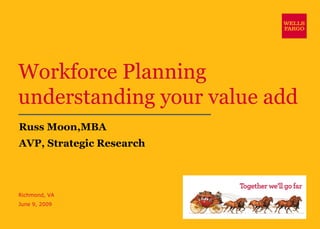Kennedy Workforce Planning
- 1. Workforce Planning understanding your value add Russ Moon,MBA AVP, Strategic Research Richmond, VA June 9, 2009
- 2. Workforce Planning Method to optimize the management of available talent supply vs. talent demand Components of workforce planning Talent management Succession planning Retirement projections
- 3. Key Considerations Seek understanding Educate and facilitate appreciation for the value add Define scope Develop measurable objectives Forecasting тАУ not an exact science, start with subset (line of business or job family)
- 4. Your Value Add Education on the need and benefits Scope definition Collaboration is key Continuous validation Simple plan brilliantly executed
- 5. Copyright/classifications: ┬й 2009 Wells Fargo Bank, N.A. All rights reserved. For public use.
Editor's Notes
- #2: Good Afternoon and welcome to today's webinar. We will be discussing Workforce planning at a macro strategic level with the objective of sharing a few ideas which you can take back to your organization to determine how to best pursue a more proactive method of managing your talent supply. My comments today represent my opinion and are presented as such, not as an official position of my employer. LetтАЩs get started with viewing some highlights of how to recognize where your value add as a senior leader could be in leading your enterprise in a workforce planning effort.
- #3: Workforce planning тАУ It is very important to develop a shared understanding of new initiatives in order to develop appreciation for the value add and the need to engage. LetтАЩs start with a basic definition of workforce planning to bring everyone to a shared understanding of exactly what we are discussing. Workforce Planning can be simple or very complex in terms of the scope. In its most basic form, Workforce planning is a method to optimize managing your available talent supply such that you have the correct amount of talent to support your business needs. Components тАУ you may have heard people mention talent management, succession planning or retirement projections. These are some of the components of Workforce Planning. Different methods use different terminology to describe similar functions of the process. Once you decide on your organizations approach ensure that your key stakeholders are clear on your terminology.
- #4: Seek Understanding тАУ a key step which should not be overlooked. As the subject matter expert, gain an appreciation for the components of workforce planning which may already be in place. Think about how those current components might work together as you move forward. Educate and facilitate тАУ Help your key stakeholders understand the concept, the terms and what they mean. Experience has demonstrated that it is truly challenging to gain buy-in when a basic understanding is not present. This is part of your value add to catalyze that understanding of the method and the value you should expect to gain by engaging in the process. Scope тАУ Workforce planning can be very complex but it doesnтАЩt have to be. My advice is to start on a smaller more manageable scope to refine your process first. Measurable objectives тАУ What does the enterprise gain ? How do we measure it ? Initially a more limited scope would be helpful. Forecasting тАУ starting with a subset allows you to refine your technique, you will minimize any initial learning curve errors and when you broaden your scope you will then have a method tailored to your organization that you can have confidence in.
- #5: Education тАУ be the expert and transfer your knowledge to your key stakeholders to help them understand the need (having appropriate levels of available talent) and the value (key available talent available in real time to support strategic business initiatives). Scope definition тАУ Start with a subset first and clearly define what is in scope and what is not. This will focus your time and energy where it adds value and supports a better understanding of how workforce planning will function тАжin your organization. Collaboration is key тАУ talent managers, line of business leaders, recruitment leaders will all have valuable insight into what the mission critical needs areтАжsolicit their input and make them part of the Scope Definition process. Learn from each other. Continuous validation тАУ check and recheck your progress vs. the plan and adjust in real time. Needs change and you should stay abreast of factors that might change the forecast. Simple plan тАУ Workforce planning does not have to be implemented at the most complex level to be effective. You can start with a basic plan with a controlled scope and still produce results. A simple plan brilliantly executed will yield more value than a plan with broader scope and weaker execution. Thank you to Kennedy Information for organizing this webinar and to all of you for your attendance today.





